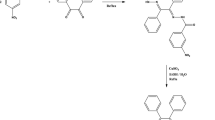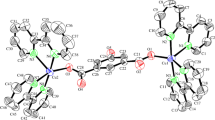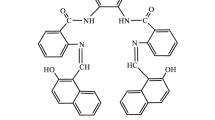Abstract
The effect of energetic γ-radiation on 1H NMR, electronic absorption, ESR spectra, differential thermal analysis (DTA) and solid state dc electrical conductivity of the ligand N-phenyl-2-(2-(phenylamino)acetyl)hydrazine carbothioamide (H2L) and its copper(II) complexes; Cu(HL)(OAc)H2O, Cu(HL)BrH2O and Cu(H2L)2(NO3)2⋅3H2O before and after γ-irradiation (hereafter referred to as (B), (B 1 ), (B 2 ), (B 3 ) and (A), (A 1 ), (A 2 ), (A 3 ), respectively) has been studied. Electronic spectral bands of the complexes after irradiation exhibited some better resolved shapes with a remarkably higher absorbance, ESR spectrum of complex Cu(HL)BrH2O (B 2 ) before irradiation showed isotropic spectrum with g iso = 2.075 however, after irradiation (A 2 ) displayed axial ESR spectrum with g ∥ > g ⊥ > 2.0023 and d (x2−y2) ground state. DTA of the compounds reveals that γ-irradiation induced generation of new peaks as well as changes in the peak intensities. Solid state dc electrical conductivity for complexes was investigated before and after γ-irradiation. Complexes were found to be semiconductors, the activation energies (E a) were calculated for the complexes by using the Arrhenius plot.





Similar content being viewed by others
References
Guzel O, Karalı N, Salman A (2008) Synthesis and antituberculosis activity of 5-methyl/trifluoromethoxy-1H-indole-2,3-dione 3-thiosemicarbazone derivatives. Bioorg Med Chem 16:8976–8987
Cocco MT, Congiu C, Onnis V, Pellerano ML, De Logu A (2002) Synthesis and antimycobacterial activity of new s-alkylisothio-semicarbazone derivatives. Bioorg Med Chem 10:501–506
Al-Soud YA, Al-Dweri MN, Al-Masoudi NA (2004) Synthesis, antitumor and antiviral properties of some 1,2,4-triazole derivatives. Il Farmaco 59:775–783
Collins FM, Klayman DL, Morrison NE (1982) Correlations between structural and antimicrobial activity in a series of thiosemicarbazones. J Gen Microbiol 128:1349–1356
Manoj E, Kurup Prathapachandra MR (2008) Structural and spectral studies of nickel(II) complexes with N(4), N(4)-(butane-1,4-diyl) thiosemicarbazones. Polyhedron 27(1):275–282
Murugkar A, Unnikrishnan B, Padhye S, Bhonde R, Teat S, Triantafillou E, Sinn E (1999) Hormone anchored metal complexes. 1. Synthesis, structure, spectroscopy and in vitro antitumor activity of testosterone acetate thiosemicarbazone and its metal complexes. Met-Based Drugs 6(3):177–182
Marzano C, Pellei M, Tisato F, Santini C (2009) Copper complexes as anticancer agents anti-cancer agents. Med Chem 9:185–211
Ramesh S, Rajeswari S, Maruthamuthu S (2004) Corrosion inhibition of copper by new triazole phosphonate derivatives. Appl Surf Sci 229:214–225
Krishnan G, Jayashri TA, Geetha Devi K (2009) Effect of gamma radiation on thermal decomposition, X-ray diffraction and electronic spectra of nickel(II) complexes of diethylenetriamine, pyridine and 2-aminopyridine. Radiat Phys Chem 78:184–190
Krishnan G, Jayashri TA, Sudha P (2009) Radiation thermal, X-ray diffraction and electronic spectral studies of gamma irradiated nickel(II) complexes of ethylenediamine, triethylenetetramine and o-toluidine. Radiat Phys Chem 78:933–938
Ocak YS, Kılıҫoğlu T, Topal G, Başkan MH (2010) Nuclear 60Co γ-irradiation effects on electrical properties of a rectifying diode based on a novel macrocyclic Zn octaamide complex. Instru Meth Phys Res A 612:360–366
Vilchis-Nestor AR, Ureña-Núñez F, Sánchez-Mendieta V, Pérez-Hernández R (2011) The efficiency of gamma-radiation relies on its capability of penetration, Catalytic activity of poly[(methacrylato)aluminum(III)] obtained at different gamma-radiation doses. Radia Phys Chem 80:1151–1157
Jayashri TA, Krishnan G (2008) Effect of gamma-radiation on thermal decomposition of bis(diethylene triamine) cobalt(II) nitrate and bis(diethylene triamine) zinc(II) nitrate. J Radioanal Nucl Chem 277(3):693–697
Khamari SK, Dixit VK, Ganguli Tapas, Porwal S, Singh SD, Kher Sanjay, Sharma RK, Oak SM (2011) Effect of 60Co γ-ray irradiation on electrical properties of GaAs epilayer and GaAs p–i–n diode. Nucl Instrum Methods Phys Res B 269:272–276
Abou Sekkina MM, Kashar TI, Aly SA (2011) Spectrochemical study and effect of high energetic gamma ray on copper(II) complexes. Solid State Sci 13:2080–2085
Halli MB, Sumathi RB, Kinni Mallikarjun (2012) Synthesis, spectroscopic characterization and biological evaluation studies of Schiff’s base derived from naphthofuran-2-carbohydrazide with 8-formyl-7-hydroxy-4-methyl coumarin and its metal complexes. Spectrochim Acta Part A Mol Biomol Spectrosc 99:46–56
El-Boraey HA, Emam SM, Tolan DA, El-Nahas AM (2011) Structural studies and anticancer activity of a novel (N6O4) macrocyclic ligand and its Cu(II) complexes. Spectrochim Acta Part A Mol Biomol Spectrosc 78:360–370
El-Boraey HA (2012) Coordination behavior of tetraaza [N4] ligand towards Co(II), Ni(II), Cu(II), Cu(I) and Pd(II) complexes: synthesis, spectroscopic characterization and anticancer activity. Spectrochim Acta Part A Mol Biomol Spectrosc 97:255–262
Procter MI, Hathaway BJ, Nicholls P (1969) The electronic properties and stereochemistry of the copper(II) ion. Part I. Bis(ethylenediamine)copper(II) complexes J Chem Soc A 1678–1684. doi:10.1039/J19680001678
Aydogdu Y, Yakuphanoglu F, Aydogdu A, Tas E, Cukurovali A (2003) Solid state electrical conductivity properties of copper complexes of novel oxime compounds containing oxolane ring. Mater Lett 57:3755–3760
Author information
Authors and Affiliations
Corresponding author
Electronic supplementary material
Below is the link to the electronic supplementary material.
Rights and permissions
About this article
Cite this article
Abou Sekkina, M.M., El-Boraey, H.A. & Aly, S.A. Further studies on the properties and effect of high energetic ionizing radiation on copper(II) complexes: 1H NMR, electronic absorption, ESR spectra and solid electrical conductivity. J Radioanal Nucl Chem 300, 867–872 (2014). https://doi.org/10.1007/s10967-014-3053-x
Received:
Published:
Issue Date:
DOI: https://doi.org/10.1007/s10967-014-3053-x




